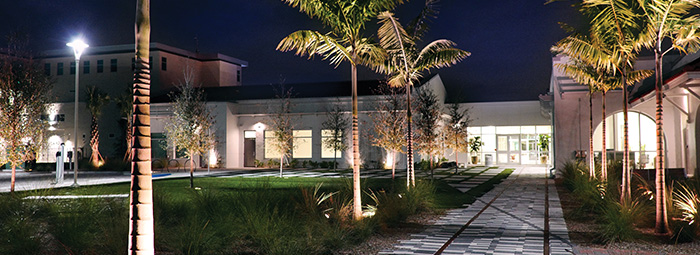
©2021 This excerpt taken from the article of the same name which appeared in ASHRAE Journal, vol. 63, no. 8, August 2021.
About the Authors
Lawrin T. Ellis, P.E., is a managing principal, Cory Duggin, P.E., is a principal, Carmine Rende Jr., P.E., is a former associate/senior project engineer and Alyssa Faircloth is an associate/engineer at TLC Engineering Solutions.
A dedicated outdoor air system coupled with gas-phase air scrubbers optimize the outdoor air volume in the renovation and addition of an historic Fort Myers, Fla., building. This resulted in rates below the minimum required for the ASHRAE Standard 62.1-2010 Ventilation Rate Procedure (VRP). In addition, contaminant concentrations stay well below Standard 62.1-2010 VRP design concentrations even during events, resulting in enhanced air quality.
The renovated 11,300 ft2 (1050 m2) Railroad Depot and 3,160 ft2 (1223 m2) addition create the Southwest Florida Community Foundation’s Collaboratory, a complex where ideas for social, economic and sustainable change are born and fostered. The design’s predicted energy use intensity (EUI) was 46 kBtu/ft2 (522 MJ/m2) and delivered a metered EUI of 30.5 kBtu/ft2 (346 MJ/m2) at the end of one year in operation.
The building earned the LEED pilot credit (EQpc 124) for Performance-Based Indoor Air Quality Design and Assessment, maximizing the credit’s potential at seven points. Each building in the complex has its own dedicated HVAC system complete with a smart, gas-phase air scrubber system, which earned an additional two points toward energy savings by reducing the volume of outdoor air required for compliance with Standard 62.1-2010 while providing enhanced air quality.
Energy Efficiency
Dedicated Outdoor Air System (DOAS)
DOAS units supply outdoor air directly to the interior spaces, resulting in higher zone air distribution effectiveness. Delivering outdoor air directly to the breathing zone eliminates inefficiencies inherent to mixed air systems and allows cycling of space conditioning systems. During heating mode the supplied ventilation air temperature is less than 15°F (8.3°C) higher than the space heating design temperature.
IAQP, LEED and Energy Use/Cost Savings Results
One of the three calculation procedures to show compliance with Standard 62.1-2010 is the Indoor Air Quality Procedure (IAQP), a method to provide performance-based compliance with minimum zone outdoor airflow values as an alternative to the Ventilation Rate Procedure (VRP) and the geometry-prescriptive path of the Natural Ventilation Procedure. Since the IAQP is based on contaminant concentrations and a subjective evaluation of perceived IAQ, it allowed the design team to take credit gas-phase air cleaning to supplement conventional ventilation.
Using gas-phase air cleaning units allows the required ventilation to be calculated using the mass balance equations for Standard 62.1-2010’s IAQP, based on the concentration of chemicals, particulates, etc., that would likely accumulate in this type of space rather than the prescriptive amount from the VRP. Ultimately, this optimized the outdoor air volume in the proposed design. This resulted in rates below the minimum required for Standard 62.1-2010’s VRP (which sets the Standard 90.1-2010 Appendix G baseline building ventilation rate), allowing for a reduction in peak cooling load and energy consumption.
Using effective indoor air cleaning technologies, tested for efficiency using ASHRAE Standard 145.2-2011, that address all contaminants of concern, including CO2, results in reduced outdoor airflow requirements, producing significant energy savings and keeping contaminants below VRP design thresholds. Using the IAQP to reduce ventilation rates without also removing CO2 will result in higher than VRP design CO2 concentrations.
Read the Full Article
ASHRAE Members have free access to the full-text PDF of this article as well as the complete ASHRAE Journal archives back to 1997 in the Free Member Access Area.
Non-members can purchase features from the ASHRAE Bookstore. Or, Join ASHRAE!
Return to Featured Article Excerpts
Return to ASHRAE Journal Featured Article Excerpts